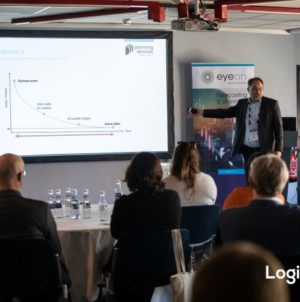-
BLACKOUT TECHNOLOGIES TARGETS TELEMATICS-INTEGRATED MOBILE DEVICE BLOCKING TO COMBAT SMARTPHONE DISTRACTION - 1 day ago
-
OpenADR Alliance announces first OpenADR 3.0 certified products with EVoke Systems, E.ON Energy and Universal Devices - March 25, 2025
-
Growing fulfilment and contract packer appoints new Managing Director - March 25, 2025
-
When is it time to invest in a WMS? Understanding the key trigger points - March 25, 2025
-
eCapital helps Vantage Recruitment on its journey to financial success - March 24, 2025
-
Hugo Beck Celebrates 70 Years of Packaging Innovation with Open House Events - March 20, 2025
-
PROLOG FULFILMENT SUPPORTS LUNA DAILY’S COMMITMENT TO BETTER BODY CARE FOR ALL WOMEN - March 19, 2025
-
Motion Ventures launches largest-ever maritime tech fund at $100M to meet the industry’s new pace of adoption - March 18, 2025
-
ITD GLOBAL APPOINTS GROUP CHIEF REVENUE OFFICER - March 17, 2025
-
SURECAM TEAMS UP WITH ENTERPRISE FLEX-E-RENT FOR VEHICLE REPAIR & MAINTENANCE CONFERENCE - March 14, 2025
EDI: As important for you today as it’s always been.
Can EDI still be the answer in 2017? Emphatically yes, but not necessarily in its familiar form, writes Stefan Köhler, Sales Director at Data Interchange.
Electronic Data Interchange (EDI) is undeniably a mature business tool. With roots in the 1960s, it was embraced by the automotive, retail and other sectors but can EDI still be the answer two decades into the 21st century? Emphatically, yes, but not necessarily in its old, familiar form.
One advantage of EDI is precisely its maturity. Many individuals, organisations and business networks have decades of experience of EDI. They know how to use it to best advantage, how to create and collate data in suitable form, how to develop new messages that work efficiently. Although there are many different, often industry-specific, standards and protocols, these are well understood. Other business systems – technical, operational, commercial and financial – are designed to work well with EDI, maximising the automation of data collection, transfer and processing. Indeed, such is the dependence of some sectors on EDI that radical change is almost inconceivable.
Paradoxically, a further advantage of EDI is that it has not stood still and continues to evolve. New standards such as MMOG, and in the public sector the PEPPOL standard, are being adopted to meet specific sector needs, and ‘open standards’ are also making inroads. The way EDI is achieved is also changing. The Cloud and the Web have led to the rise of EDI as a managed service, available to sets of business partners with minimal upfront cost and without the need to retain a staff of EDI specialists. For the user, such services are agnostic as to which standards and protocols individual organisations are using. The core benefits of EDI remain but they are now much more widely accessible.
This is important because the need to handle and transfer large amounts of data is growing remorselessly. This even applies to smaller firms that have hitherto operated quite happily with emails and phone calls. There are many reasons for this. Customisation and make to order – best seen in the automotive industry – increase traffic greatly. Where one set of messages might govern a whole shift’s production of a single model, now an equivalent set of data is needed for each vehicle.
There are other factors. Product life cycles are shorter and demand is increasingly unpredictable. Multiple channels to market increase data flows and there is a blurring of distinctions between B2B and B2C – business customers have a tendency to act more like consumers in placing many more orders for smaller quantities over shorter timeframes. Imminent developments such as the Internet of Things can only increase the demand for data transfer even further. To meet these challenges, orders, instructions and variations have to be issued and acted upon much faster, and often simultaneously by players at different levels in the business network. This data needs to be accurate and incorruptible, inexpensive to handle and as far as possible immune to costly and error-prone manual intervention.
So even small firms and relatively simple supply chains face the need for efficient and accurate dissemination of increasing amounts of data. Nor is this requirement limited to manufacture and retail. In services, particularly in data-dependent services such as health, there are similar pressures.
EDI, especially as a managed service, is an affordable, accessible and dependable solution that’s as important for you today as it’s always been.
For further information, contact: www.datainterchange.com

































